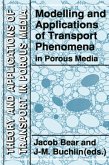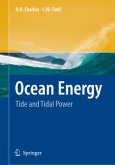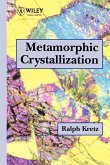S. Maaloe
Principles of Igneous Petrology
S. Maaloe
Principles of Igneous Petrology
- Broschiertes Buch
- Merkliste
- Auf die Merkliste
- Bewerten Bewerten
- Teilen
- Produkt teilen
- Produkterinnerung
- Produkterinnerung
Igneous petrology was to some extent essentially a descriptive sci ence until about 1960. The results were mainly obtained from field work, major element analyses, and microscopical studies. During the 1960's two simultaneous developments took place, plate tectonics became generally accepted, and the generation of magmas could now be related to the geodynamic features like convection cells and subduction zones. The other new feature was the development of new analytical apparatus which allowed high accuracy analyses of trace elements and isotopes. In addition it became possible to do ex…mehr
Andere Kunden interessierten sich auch für
![Modelling and Applications of Transport Phenomena in Porous Media Modelling and Applications of Transport Phenomena in Porous Media]() Modelling and Applications of Transport Phenomena in Porous Media124,99 €
Modelling and Applications of Transport Phenomena in Porous Media124,99 €![Time- and Strata-Bound Ore Deposits Time- and Strata-Bound Ore Deposits]() Time- and Strata-Bound Ore Deposits77,99 €
Time- and Strata-Bound Ore Deposits77,99 €![Thermodynamic Data on Oxides and Silicates Thermodynamic Data on Oxides and Silicates]() Surendra K. SaxenaThermodynamic Data on Oxides and Silicates77,99 €
Surendra K. SaxenaThermodynamic Data on Oxides and Silicates77,99 €![Sterne, Äpfel und rundes Glas Sterne, Äpfel und rundes Glas]() Susanne SchäferSterne, Äpfel und rundes Glas12,00 €
Susanne SchäferSterne, Äpfel und rundes Glas12,00 €![Stratabound Ore Deposits in the Andes Stratabound Ore Deposits in the Andes]() Stratabound Ore Deposits in the Andes75,99 €
Stratabound Ore Deposits in the Andes75,99 €![Ocean Energy Ocean Energy]() Roger H. CharlierOcean Energy110,99 €
Roger H. CharlierOcean Energy110,99 €![Metamorphic Crystallization Metamorphic Crystallization]() Ralph KretzMetamorphic Crystallization361,99 €
Ralph KretzMetamorphic Crystallization361,99 €-
-
-
-
-
-
-
-
-
-
-
Igneous petrology was to some extent essentially a descriptive sci ence until about 1960. The results were mainly obtained from field work, major element analyses, and microscopical studies. During the 1960's two simultaneous developments took place, plate tectonics became generally accepted, and the generation of magmas could now be related to the geodynamic features like convection cells and subduction zones. The other new feature was the development of new analytical apparatus which allowed high accuracy analyses of trace elements and isotopes. In addition it became possible to do ex perimental studies at pressures up to 100 kbar. During the 1970's a large amount of analytical data was obtained and it became evident that the igneous processes that control the compositions of magmas are not that simple to determine. The composition of a magma is controlled by the compositions of its source, the degree of partial melting, and the degree of fractionation. In order to understand the significance of these various processes the relationship between the physical processes and their geochemical consequences should be known. Presently there are several theories that attempt to explain the origin of the various magma types, and these theories can only be evaluated by turning the different ideas into quantitative models. We will so to speak have to do some book keeping for the various theories in order to see which ones are valid. the present book is intended as an introduction to the more fun damental aspects of quantitative igneous petrology.
Produktdetails
- Produktdetails
- Verlag: Springer / Springer Berlin Heidelberg / Springer, Berlin
- Artikelnr. des Verlages: 978-3-642-49356-0
- Softcover reprint of the original 1st ed. 1985
- Seitenzahl: 392
- Erscheinungstermin: 25. April 2012
- Englisch
- Abmessung: 244mm x 170mm x 22mm
- Gewicht: 666g
- ISBN-13: 9783642493560
- ISBN-10: 3642493564
- Artikelnr.: 36121909
- Verlag: Springer / Springer Berlin Heidelberg / Springer, Berlin
- Artikelnr. des Verlages: 978-3-642-49356-0
- Softcover reprint of the original 1st ed. 1985
- Seitenzahl: 392
- Erscheinungstermin: 25. April 2012
- Englisch
- Abmessung: 244mm x 170mm x 22mm
- Gewicht: 666g
- ISBN-13: 9783642493560
- ISBN-10: 3642493564
- Artikelnr.: 36121909
I Monary Systems.- 1 Introduction.- 2 Monary Phase Relations.- 3 Phase Changes Within the Upper Mantle.- II Binary Systems.- 1 Introduction.- 2 The Phase Rule.- 3 The Lever Rule.- 4 Binary Isomorphous Systems.- 5 Equilibrium Crystallization.- 6 Fractional Crystallization.- 7 Influence of Additional Components and Pressure.- 8 Partial Melting.- 9 Binary Isomorphous System with Minimum.- 10 Eutectic Systems.- 11 Partial Melting.- 12 Eutectic System with Solid Solution.- 13 Partial Melting.- 14 Peritectic Systems.- 15 Equilibrium Crystallization.- 16 Fractional Crystallization.- 17 Partial Melting.- 18 Peritectic System with Solid Solution.- 19 Equilibrium Crystallization.- 20 Fractional Crystallization.- 21 Partial Melting.- 22 Congruent System.- 23 Binary Exsolution.- 24 Liquid Immiscibility.- 25 Principles of Construction.- III Ternary Systems.- 1 Introduction.- 2 Gibbs' Triangle.- 3 Coordinate Transformations.- 4 Space Diagram and Projection.- 5 Ternary Eutectic System.- 6 Crystallization.- 7 Partial Melting.- 8 Ternary Lever Rules.- 9 Swanson's II Rule.- 10 The Tangent Rule.- 11 Quantitative Analysis - Trend Estimate.- 12 Binary and Ternary Congruent Compounds.- 13 Crystallization Vectors.- 14 Ternary Peritectic System.- 15 Equilibrium Crystallization.- 16 Fractional Crystallization.- 17 Partial Melting of Composition Z.- 18 Solid Solution.- 19 One Solid Phase.- 20 Albite-Anorthite-Silica System.- 21 Equilibrium Crystallization.- 22 Fractional Crystallization.- 23 Solid Solution - Two Solids.- 24 Equilibrium Crystallization.- 25 Fractional Crystallization.- 26 Solid Solution - Peritectic System.- 27 Types of Univariant Curves in Ternary Systems.- 28 Eutectic Crystallization.- 29 Eutectic-Peritectic Transition.- 30 Peritectic Crystallization.- 31 Peritectic-Eutectic Transition.- IV Pseudobinary Systems.- 1 Introduction.- 2 Rhines Phase Rule.- 3 Ternary Eutectic System.- 4 Ternary System with a Congruent Compound.- 5 Ternary System with an Incongruent Compound.- 6 Ternary System with Two Incongruent Compounds.- 7 Pseudobinary Joins Within the Ternary Systems Wollastonite-Enstatite-Alumina.- V P-T Diagrams.- 1 Pressure-Temperature Diagrams.- 2 Eutectic System.- 3 Congruent-Incongruent Transition.- 4 Congruent Compound.- 5 Ternary Eutectic System.- 6 Lherzolite.- 7 Tholeiite.- VI Schreinemakers' Phase Theory.- 1 Introduction.- 2 Variance.- 3 The P-T-x Diagram for a Binary Eutectic System.- 4 The Bounding Theorem.- 5 Morey-Schreinemakers' Theorem.- 6 The Overlap Theorem.- 7 Principle of Opposition.- 8 Arrangement of Univariant Curves.- 9 Monary Systems.- 10 Binary Systems.- 11 Degenerate Systems.- 12 Ternary Systems.- 13 Examples of Ternary Chemographs.- 14 Quaternary Systems.- VII Gas-Bearing Systems.- 1 Introduction.- 2 Binary and Multicomponent Phase Relations.- 3 P-T Diagrams of Rock-H2O Systems.- 4 Phase Relations in the Presence of Carbon Dioxide.- 5 CaO-MgO-CO2.- 6 Carbonation Reactions.- 7 Liquid Immiscibility.- 8 Gas Contents of Magmas.- 9 Nominal Anhydrous Minerals.- VIII Oxygen Fugacity.- 1 Introduction.- 2 Equations of State for Gases.- 3 Ideal Gases.- 4 Mixtures of Ideal Gases.- 5 Van der Waals' Equation of State.- 6 Reduced Equation of State.- 7 Fugacity.- 8 Fugacity of Van der Waals' Gas.- 9 Coefficient of Fugacity from Reduced Parameters.- 10 Solid Buffers.- IX Partial Melting.- 1 Introduction.- 2 Parameters Controlling Primary Magmas.- 3 Estimation of Primary Magma Compositions.- 4 Partial Melting in a Ternary Eutectic System.- 5 Partial Melting of Lherzolite.- 6 Melting Curves of Lherzolite.- 7 Partial Melting of a Granitic Composition.- 8 Influence of Pressure on the Liquid Composition.- 9 Partial Melting by Adiabatic Ascent.- 10 Adiabatic Ascent of a One-Component System.- 11 Adiabatic Ascent of a Ternary System.- 12 Partial Melting of Lherzolite.- 13 Geochemical Relationships of Partial Melting.- 14 Types of Partial Melting.- 15 Batch Melting, One Solid Phase.- 16 Fractional Melting, One Solid Phase.- 17 Critical Melting.- 18 The Distribution Coefficient for a Multiphased Assemblage.- 19 Treuil's Method.- 20 R/I Discrimination Method.- X Fractional Crystallization.- 1 Introduction.- 2 Phase Relations of Fractional Crystallization.- 3 Thermal Barriers.- 4 The System Albite-Orthoclase-Quartz.- 5 Rayleigh Fractionation.- 6 Types of Fractional Crystallization.- 7 Perfect Fractional Crystallization.- 8 Partial Fractional Crystallization.- 9 The Calculation Procedure for a General Fractionation Formula of Binary Systems.- 10 Olivine Fractionation in Basalts.- 11 Trace Element Fractionation.- 12 Analysis of Trends.- 13 Trend and Control Lines.- 14 The Minimal Enrichment Ratio ?.- 15 Analysis of the Fractionate.- 16 The Linear Equation Method and the Least Square Method.- 17 Statistics of Chemical Data.- XI Magma Kinetics.- 1 Diffusion.- 2 The Diffusion Process.- 3 Temperature Dependence of D.- 4 Pressure Dependence of D.- 5 Diffusion in Gases and Liquids.- 6 Diffusion in Solids.- 7 Diffusion Equations.- 8 Interfacial Energy.- 9 Latent Heat and Interfacial Energy.- 10 Supercooling.- 11 Nucleation.- 12 Thermodynamics of Nucleation.- 13 The Nucleation of Gold.- 14 Kinetics of Nucleation.- 15 Nucleation in Magmas.- 16 Experimental Results.- 17 Crystal Growth.- 18 The Crystal Surface.- 19 Surface Nucleation.- 20 Screw Dislocations.- 21 Continuous Growth.- 22 Crystal Habits.- 23 Diffusion Controlled Growth.- 24 Constitutional Supercooling.- 25 Heat Dissipation Controlled Growth.- XII Magma Dynamics.- 1 Introduction.- 2 Densities of Rocks and Glasses.- 3 Viscosity of Magmas.- 4 Viscosity - Temperature Dependence.- 5 Viscosity - Pressure Dependence.- 6 Non-Newtonian Behavior.- 7 Gravity Settling of Phenocrysts.- 8 Mantle Rheology.- 9 Convection.- 10 Convection Physics.- 11 Plumes and Diapirs.- 12 Initial Instability.- 13 Plume Formation and Ascent Rate.- 14 Dynamic Aspects of Partial Melting.- 15 Permeability.- 16 Flow in Permeable Media.- 17 Melt Accumulation by Matrix Melting.- 18 Dyke Propagation.- 19 Pressure Relationships of Magmas.- 20 Laminar and Turbulent Flow.- 21 Reynolds' Number.- 22 Turbulent Flow.- 23 Ascent Rate and Eruption Rate.- XIII Isotope Geology.- 1 Introduction.- 2 Basic Equations.- 3 Rubidium-Strontium Dating.- 4 Meteorites.- 5 87Sr/86Sr Ratios of Basalts.- 6 Samarium-Neodynium Dating.- 7 The Nd-Sr Correlation.- 8 Andesites and Granites.- 9 Noble Gas Isotopes.- 10 K-Ar Dating.- 11 Oxygen Isotopes.- 12 Fractionation of Oxygen Isotopes.- References.
I Monary Systems.- 1 Introduction.- 2 Monary Phase Relations.- 3 Phase Changes Within the Upper Mantle.- II Binary Systems.- 1 Introduction.- 2 The Phase Rule.- 3 The Lever Rule.- 4 Binary Isomorphous Systems.- 5 Equilibrium Crystallization.- 6 Fractional Crystallization.- 7 Influence of Additional Components and Pressure.- 8 Partial Melting.- 9 Binary Isomorphous System with Minimum.- 10 Eutectic Systems.- 11 Partial Melting.- 12 Eutectic System with Solid Solution.- 13 Partial Melting.- 14 Peritectic Systems.- 15 Equilibrium Crystallization.- 16 Fractional Crystallization.- 17 Partial Melting.- 18 Peritectic System with Solid Solution.- 19 Equilibrium Crystallization.- 20 Fractional Crystallization.- 21 Partial Melting.- 22 Congruent System.- 23 Binary Exsolution.- 24 Liquid Immiscibility.- 25 Principles of Construction.- III Ternary Systems.- 1 Introduction.- 2 Gibbs' Triangle.- 3 Coordinate Transformations.- 4 Space Diagram and Projection.- 5 Ternary Eutectic System.- 6 Crystallization.- 7 Partial Melting.- 8 Ternary Lever Rules.- 9 Swanson's II Rule.- 10 The Tangent Rule.- 11 Quantitative Analysis - Trend Estimate.- 12 Binary and Ternary Congruent Compounds.- 13 Crystallization Vectors.- 14 Ternary Peritectic System.- 15 Equilibrium Crystallization.- 16 Fractional Crystallization.- 17 Partial Melting of Composition Z.- 18 Solid Solution.- 19 One Solid Phase.- 20 Albite-Anorthite-Silica System.- 21 Equilibrium Crystallization.- 22 Fractional Crystallization.- 23 Solid Solution - Two Solids.- 24 Equilibrium Crystallization.- 25 Fractional Crystallization.- 26 Solid Solution - Peritectic System.- 27 Types of Univariant Curves in Ternary Systems.- 28 Eutectic Crystallization.- 29 Eutectic-Peritectic Transition.- 30 Peritectic Crystallization.- 31 Peritectic-Eutectic Transition.- IV Pseudobinary Systems.- 1 Introduction.- 2 Rhines Phase Rule.- 3 Ternary Eutectic System.- 4 Ternary System with a Congruent Compound.- 5 Ternary System with an Incongruent Compound.- 6 Ternary System with Two Incongruent Compounds.- 7 Pseudobinary Joins Within the Ternary Systems Wollastonite-Enstatite-Alumina.- V P-T Diagrams.- 1 Pressure-Temperature Diagrams.- 2 Eutectic System.- 3 Congruent-Incongruent Transition.- 4 Congruent Compound.- 5 Ternary Eutectic System.- 6 Lherzolite.- 7 Tholeiite.- VI Schreinemakers' Phase Theory.- 1 Introduction.- 2 Variance.- 3 The P-T-x Diagram for a Binary Eutectic System.- 4 The Bounding Theorem.- 5 Morey-Schreinemakers' Theorem.- 6 The Overlap Theorem.- 7 Principle of Opposition.- 8 Arrangement of Univariant Curves.- 9 Monary Systems.- 10 Binary Systems.- 11 Degenerate Systems.- 12 Ternary Systems.- 13 Examples of Ternary Chemographs.- 14 Quaternary Systems.- VII Gas-Bearing Systems.- 1 Introduction.- 2 Binary and Multicomponent Phase Relations.- 3 P-T Diagrams of Rock-H2O Systems.- 4 Phase Relations in the Presence of Carbon Dioxide.- 5 CaO-MgO-CO2.- 6 Carbonation Reactions.- 7 Liquid Immiscibility.- 8 Gas Contents of Magmas.- 9 Nominal Anhydrous Minerals.- VIII Oxygen Fugacity.- 1 Introduction.- 2 Equations of State for Gases.- 3 Ideal Gases.- 4 Mixtures of Ideal Gases.- 5 Van der Waals' Equation of State.- 6 Reduced Equation of State.- 7 Fugacity.- 8 Fugacity of Van der Waals' Gas.- 9 Coefficient of Fugacity from Reduced Parameters.- 10 Solid Buffers.- IX Partial Melting.- 1 Introduction.- 2 Parameters Controlling Primary Magmas.- 3 Estimation of Primary Magma Compositions.- 4 Partial Melting in a Ternary Eutectic System.- 5 Partial Melting of Lherzolite.- 6 Melting Curves of Lherzolite.- 7 Partial Melting of a Granitic Composition.- 8 Influence of Pressure on the Liquid Composition.- 9 Partial Melting by Adiabatic Ascent.- 10 Adiabatic Ascent of a One-Component System.- 11 Adiabatic Ascent of a Ternary System.- 12 Partial Melting of Lherzolite.- 13 Geochemical Relationships of Partial Melting.- 14 Types of Partial Melting.- 15 Batch Melting, One Solid Phase.- 16 Fractional Melting, One Solid Phase.- 17 Critical Melting.- 18 The Distribution Coefficient for a Multiphased Assemblage.- 19 Treuil's Method.- 20 R/I Discrimination Method.- X Fractional Crystallization.- 1 Introduction.- 2 Phase Relations of Fractional Crystallization.- 3 Thermal Barriers.- 4 The System Albite-Orthoclase-Quartz.- 5 Rayleigh Fractionation.- 6 Types of Fractional Crystallization.- 7 Perfect Fractional Crystallization.- 8 Partial Fractional Crystallization.- 9 The Calculation Procedure for a General Fractionation Formula of Binary Systems.- 10 Olivine Fractionation in Basalts.- 11 Trace Element Fractionation.- 12 Analysis of Trends.- 13 Trend and Control Lines.- 14 The Minimal Enrichment Ratio ?.- 15 Analysis of the Fractionate.- 16 The Linear Equation Method and the Least Square Method.- 17 Statistics of Chemical Data.- XI Magma Kinetics.- 1 Diffusion.- 2 The Diffusion Process.- 3 Temperature Dependence of D.- 4 Pressure Dependence of D.- 5 Diffusion in Gases and Liquids.- 6 Diffusion in Solids.- 7 Diffusion Equations.- 8 Interfacial Energy.- 9 Latent Heat and Interfacial Energy.- 10 Supercooling.- 11 Nucleation.- 12 Thermodynamics of Nucleation.- 13 The Nucleation of Gold.- 14 Kinetics of Nucleation.- 15 Nucleation in Magmas.- 16 Experimental Results.- 17 Crystal Growth.- 18 The Crystal Surface.- 19 Surface Nucleation.- 20 Screw Dislocations.- 21 Continuous Growth.- 22 Crystal Habits.- 23 Diffusion Controlled Growth.- 24 Constitutional Supercooling.- 25 Heat Dissipation Controlled Growth.- XII Magma Dynamics.- 1 Introduction.- 2 Densities of Rocks and Glasses.- 3 Viscosity of Magmas.- 4 Viscosity - Temperature Dependence.- 5 Viscosity - Pressure Dependence.- 6 Non-Newtonian Behavior.- 7 Gravity Settling of Phenocrysts.- 8 Mantle Rheology.- 9 Convection.- 10 Convection Physics.- 11 Plumes and Diapirs.- 12 Initial Instability.- 13 Plume Formation and Ascent Rate.- 14 Dynamic Aspects of Partial Melting.- 15 Permeability.- 16 Flow in Permeable Media.- 17 Melt Accumulation by Matrix Melting.- 18 Dyke Propagation.- 19 Pressure Relationships of Magmas.- 20 Laminar and Turbulent Flow.- 21 Reynolds' Number.- 22 Turbulent Flow.- 23 Ascent Rate and Eruption Rate.- XIII Isotope Geology.- 1 Introduction.- 2 Basic Equations.- 3 Rubidium-Strontium Dating.- 4 Meteorites.- 5 87Sr/86Sr Ratios of Basalts.- 6 Samarium-Neodynium Dating.- 7 The Nd-Sr Correlation.- 8 Andesites and Granites.- 9 Noble Gas Isotopes.- 10 K-Ar Dating.- 11 Oxygen Isotopes.- 12 Fractionation of Oxygen Isotopes.- References.








